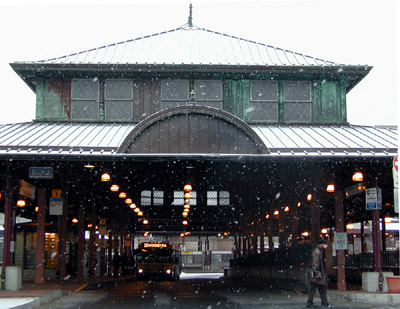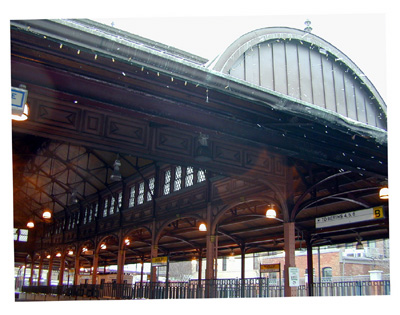I want to start with the notion of “preservation” in a non-architectural context. We say of someone – almost always a woman, because in our culture, a woman’s “looks” are still widely held to be her most important aspect – that she is “well-preserved.” No one, of course, would say this to anyone’s face because it is so deeply offensive. It’s not just that it is insulting; it is disgusting. When I hear it I think of an organ floating in formaldehyde.
Yet our feelings about this kind of “preservation” are deeply ambivalent. We live in a country, after all, in which cosmetic surgery is a billion dollar industry, and much of it aspires either to “preserve” (to arrest or stop change – think wrinkles and botox) or to “restore” (to take the body back to an earlier, i.e., younger,age before the effects of time and experience become evident – think breast lifts, tummy tucks, liposuction, etc.).
Yet I would guess that most of us know in a deeper part of our consciousness, that even if we don’t find it immoral, it is profoundly foolish and futile. I think that’s because we know that we are ‘alive,’ that the processes we are attempting to arrest are continuing under the surface, as it were, and that there will be a day of reckoning when we will see that we look grotesque in comparison with someone who has allowed ‘nature’ to take its course.
But despite this, it’s not only our own looks we strive to preserve. We also subject nature itself to strenuous attempts to ‘preserve’ its current form, just as we try to prevent our own aging.
Consider the Mississippi River system. The U.S. Army Corps of Engineers has spent billions of dollars in the last seventy-five years to stop the Mississippi from flooding. There have been competing theories about how to go about this, but the dominant one has been building higher and higher levees on either side to keep the water from carving new pathways and overspilling its banks. Yet the kind of stasis this approach aspires to is hostile to the nature of nature, which is ever changing, and, as John McPhee pointed out eighteen years ago in his magisterial The Control of Nature, and Hurricane Katrina more recently confirmed, it is an effort ultimately doomed to failure. Why? Because it necessarily worsens the peril it seeks to overcome. Flooding is natural, and when it is allowed to occur naturally, its effects are much less severe, both because it does not build up as much force between floods, and because the wetlands left by previous floods create a kind of safety valve which absorb a significant amount of water and lower the rate at which rivers rise. Hence, holding the water in doesn’t ultimately prevent flooding; it just assures that floods will be much more destructive when they come.
As with water, so it is with fire. Because rich people wish to build homes near areas of great natural beauty, the U.S. Forest Service, like the Corps of Engineers and the Cosmetic Surgeons, is under increasing pressure to “Prevent Forest Fires.” So the brush, which is naturally thinned out by frequent, naturally occurring forest fires, builds up and up. The results can be seen in the Southern California fire season of 2007, the worst ever.
Now let us turn to architectural preservation and restoration. From what I have so far said, you would be forgiven for thinking I am about to rant against preservation and restoration tout court.
Not at all. I just want to establish a context for evaluating those attempts. First of all, there are important differences. Though buildings and other architectural structures are ultimately created out of materials from nature, they are not themselves ‘alive’ in the same sense as people and forests, and so the forces of nature bear on them principally from the outside, not from within. Secondly, if everything ever built were to be preserved, we would have no space, time or money to do anything new, and new arrangements of atoms is what we humans are all about. For this reason, deliberately selecting certain structures for preservation and not others makes sense. Note too that because structures are not alive in the same sense as humans, preserving some and not others does not cause the outrage that analogous efforts do when applied to living creatures by eugenicists.
Yet how we go about architectural preservation varies very widely. I first discovered this while making a video documentary about the recycling of Boston’s original Elevated Subway, which was built in the late 1890’s and was being torn down in the late
1980’s.* To many Bostonians, the elevated was simply an eyesore, the sooner disposed of the better. Others, more historically oriented, while agreeing it was ugly and blighted, wanted to restore at least some of it to its original splendor. These people were delighted when they succeeded in getting Northampton station carefully lifted down instead of demolished. It was trucked to the harbor, then put on a barge and sent up to the Seaside Trolley Museum in Kennebunkport, Maine, to be cleaned up and put on exhibit as it looked when first built one hundred years earlier.
One of the most thoughtful observers and actors in this process was Byron Rushing, now a state senator, then the director of the Afro-American Museum of History. Byron was scornful of both the prettifying and decontextualization of Northampton Station, which he referred to harshly as “Fascist Preservation.” Originally, he had wanted the whole elevated, which he compared to “The Eiffel Tower on its side,” left up and used as a bike path connecting Jamaica Plain and Roxbury with downtown. When this idea was hooted down by pretty much everyone, he adopted a more realistic route to what he called “humane preservation” which today we would call “adaptive re-use.” Largely through his efforts, the old elevated Dudley Station was lowered to street level, minimally modified in design and imaginatively re-purposed as one of the handsomest bus stations in the U.S.

Note how radically different these two strategies of preservation are. Arguably, the architectural purity of Northampton Station was respected more than that of Dudley Station. But Rushing would argue, and I think he is right, that when a structure is ripped out of its context, the result is utterly sterile, no matter how faithful the design may be. What makes the new Dudley Bus Station work is that it resonates with the community which had grown up around it. What makes structures worthy of preservation is not just their “beauty” but the role they play in the lives of the community that surrounds them. Rushing described how one of the city busses he was riding actually missed its turn onto Washington Street in the absence of the elevated structure. He added: “I don’t think we realized just how deeply this structure was embedded in our consciousness.”

Here we see that structures, like people, are very much a part of our ongoing engagement with the world and with ourselves. One of the things I discovered through interviewing for the elevated documentary was how moved by the demolition older residents were. Many of them associated the ‘El’with freedom, because riding on it to downtown in their youth was a key stage in becoming independent of their parents. When they saw it coming down, it made them aware of their own mortality, aware that they were coming down too. Because I was an older filmmaker, that resonated with me as well.
When I was young, when I thought of death at all, I thought how great it would be to die with my boots on, in the midst of life. I had an older cousin who had been striding confidently down Fifth Avenue on her way to a rehearsal for a television series which had revived her acting career at the age of sixty-two. She experienced a massive cerebral hemorrhage and was dead before she hit the pavement. I thought that was the coolest way to go.
It was, no doubt, for her. But it was extremely hard on her husband and children, because there was no time to say goodbye, to nurture and appreciate her as she declined. She was just gone. Now that I am old myself, I better understand the cruelty of sudden death. I think that’s a piece of why it is so important to those of us who rode the El that Dudley station did not simply disappear, but was re-purposed. It gives us a chance to savor and appreciate the old structure anew, both for what it was and for what it has become.
Ultimately, of course, the new old Dudley Station will fall into disrepair, will be torn down, will disappear. As will I, and thee. But even then, as the late Philip Morrison, an astrophysicist commenting on the recycling of the bulk of the old Elevated in an electro-furnace in Osaka, Japan, observed:
"Everything of matter, this little broken bolt [taken from the El], my hand, the air, all are made of little individual parts called atoms; and they don’t get lost, don’t get created nor destroyed. So all we can do is shuffle atoms around. It’s like shuffling cards. I can get all kinds of hands of poker, but it’s always the same fifty-two cards, if it’s a fair game. But of course nature only plays fair games."
The nicest thing about that level of preservation is: it’s not a moral duty; only a necessity.
*Conservation of Matter: The Fall and Rise of Boston’s Elevated Subway (http://www.blinktank.net); may be purchased from: http://www.buyindies.com


